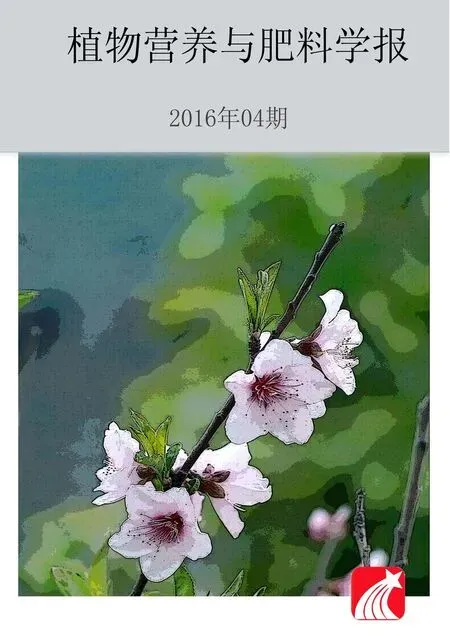水氮用量对设施栽培蔬菜地土壤氨挥发损失的影响
李银坤, 武雪萍, 武其甫, 吴会军
(1 北京农业智能装备技术研究中心, 北京 100097; 2 中国农业科学院农业资源与农业区划研究所,耕地培育技术国家工程实验室, 北京 100081; 3 内蒙古低碳发展研究院, 内蒙古呼和浩特 010010)
水氮用量对设施栽培蔬菜地土壤氨挥发损失的影响
李银坤1, 武雪萍2*, 武其甫3, 吴会军2
(1 北京农业智能装备技术研究中心, 北京 100097; 2 中国农业科学院农业资源与农业区划研究所,耕地培育技术国家工程实验室, 北京 100081; 3 内蒙古低碳发展研究院, 内蒙古呼和浩特 010010)

灌溉; 氮肥; 菜地; 铵态氮浓度; 氨挥发速率; 产量

长期以来对土壤氨挥发的研究多集中于大田[11-12],设施菜地土壤氨挥发的报道较少。我国设施蔬菜种植模式中,黄瓜和番茄轮作最为普遍,但目前尚缺少不同水肥条件下氨挥发周年动态变化方面的研究,而且对黄瓜和番茄轮作周期内氨挥发损失量及其影响因子尚不明确。本研究以华北平原设施黄瓜-番茄菜地为研究对象,通过设置不同水氮条件,探讨黄瓜-番茄种植体系内的氨挥发特征及其影响因素,以揭示影响设施菜地土壤氨挥发的重要因子,为建立合理的灌溉和施肥制度提供科学依据。
1 材料与方法
1.1试验材料
试验点位于河北省辛集市马庄科园农场内(37°78′N,115°30′E)。该区域属暖温带半湿润大陆性气候,年均气温12.5℃,年日照时数2629.5 h,全年无霜期190 d。试验用日光温室长39 m、 宽7.5 m,供试土壤为壤质潮土。定位试验开始于2008年2月,种植制度为黄瓜-番茄轮作,试验开始前0—20 cm土层土壤有机质含量15.4 g/kg,全氮1.55 g/kg,速效磷32.4 mg/kg,速效钾165.3 mg/kg,土壤容重1.35 g/cm3,田间持水率23.7%。
1.2试验设计

1.3测定项目与方法
氨挥发由通气法测定[13]。首先用磷酸甘油溶液均匀浸泡海绵(直径16 cm,厚度2 cm),然后将其横置于聚氯乙烯硬质塑料管中(直径15 cm,高10 cm)。下层海绵距管底部5 cm,用于吸收来自土壤中的挥发氨; 上层海绵与管顶部齐平,用于吸收空气中的氨,以避免污染下层海绵。双层海绵布置好后将塑料管插入土壤(约2 cm)。取样时,将下层海绵取出后放入自封袋,迅速带回实验室用浓度为1 mol/L的氯化钾溶液振荡浸提,浸提液经滤纸过滤后由流动分析仪测定铵态氮含量。每试验小区布置2个氨挥发取样装置,一般在施肥后的1、 3、 5、 7、 10 d取样,若2次施肥间隔较长,则适当增加取样次数。
土壤氨挥发速率(F)=M/(A×D)×10-2
式中, F为土壤氨挥发速率[kg/(hm2·d)]; M为取样装置单位时间内吸收的氨量(NH3-N mg); A为氨挥发取样装置的横截面积(m2); D为每次连续取样的时间(d)。
式中,Mt为土壤氨挥发量(kg/hm2);i为采样次数;t为采样时间,即定植后天数(d)。
氨挥发损失率(%)=(施氮区氨挥发量-不施氮区氨挥发量)/施氮量×100。
在氨挥发取样的当天,另在氨挥发取样装置周围10 cm处采集0—10 cm土样,测定土壤含水量及其铵态氮含量。其中土壤孔隙含水量(WFPS,%)=土壤容重×土壤含水量/(1-土壤容重/2.65)
黄瓜(番茄)以小区为单位进行采摘,由电子天平称重,并在植株拉秧后统计总产量。计算氮肥农学效率和灌溉水利用效率。
氮肥农学效率(kg/kg)=(施氮区黄瓜产量-不施氮区黄瓜产量)/施氮量。
灌溉水利用效率(kg/m3)=产量/灌水量。
统计分析软件用SAS,最小显著差异法(Duncan)进行多重比较,Pearson法进行相关性分析。
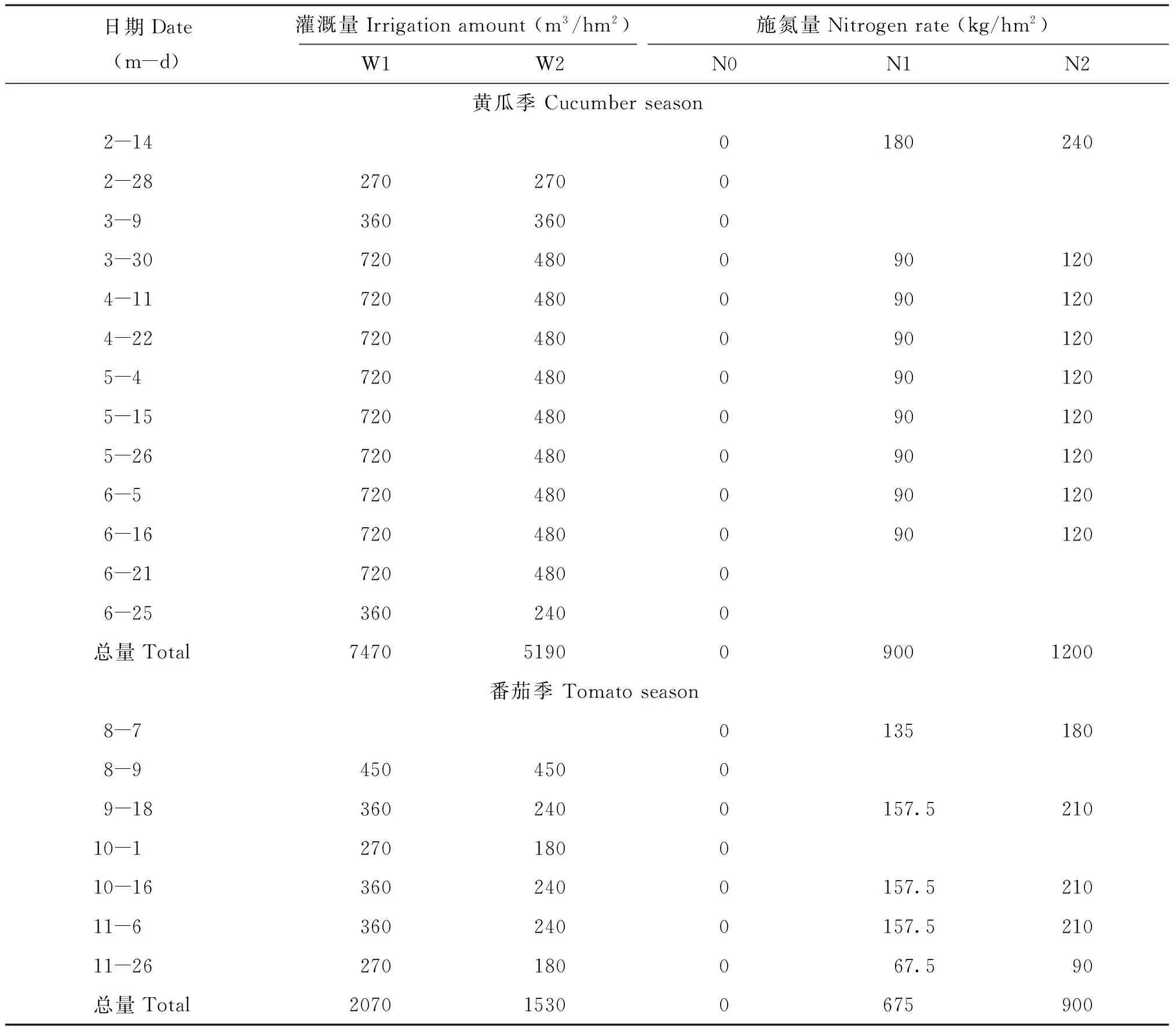
表1 设施黄瓜-番茄种植体系中灌水及氮用量
2 结果与分析
2.1表层土壤铵态氮动态变化

2.2土壤氨挥发速率的动态变化

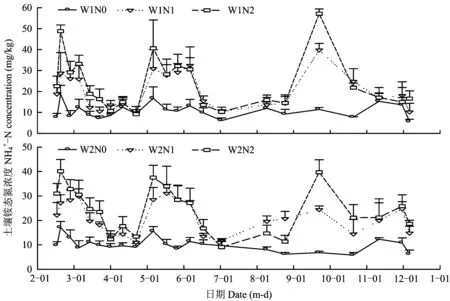
图1 设施黄瓜-番茄体系内0—10 cm土壤铵态氮浓度动态变化Fig.1 Changes of soil -N concentration (0-10 cm) in the cucumber-tomato rotation system
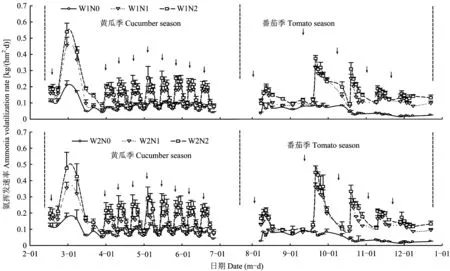
图2 黄瓜-番茄生长季内土壤氨挥发动态变化Fig. 2 Dynamics of soil ammonia volatilization during the cucumber-tomato growing seasons[注(Note): 箭头表示追肥日期 Arrows indicate the dates of fertilization.]

2.3土壤氨挥发损失量


表2 黄瓜-番茄种植体系内土壤氨挥发损失量
注(Note): 同列数据后不同字母表示差异达5%显著水平 Values followed by different letters in the same column are significantly different at the 5% level.
2.4表层土壤铵态氮含量与土壤氨挥发速率关系
统计分析表明,各处理土壤氨挥发速率与表层(0—10 cm)土壤铵态氮浓度均呈正相关关系,除不施氮处理W1N0和W2N0外,均达显著或极显著相关(图3)。可见,土壤铵态氮浓度是设施菜地土壤氨挥发的重要影响因子。
2.5黄瓜-番茄的氮肥和灌溉水利用效率

3 讨论
3.1施氮量对设施菜地土壤氨挥发的影响


图3 土壤氨挥发速率与0—10 cm土壤铵态氮浓度的关系Fig. 3 Corelations between the ammonia volatilization rate and the 0-10 cm soil -N concentration
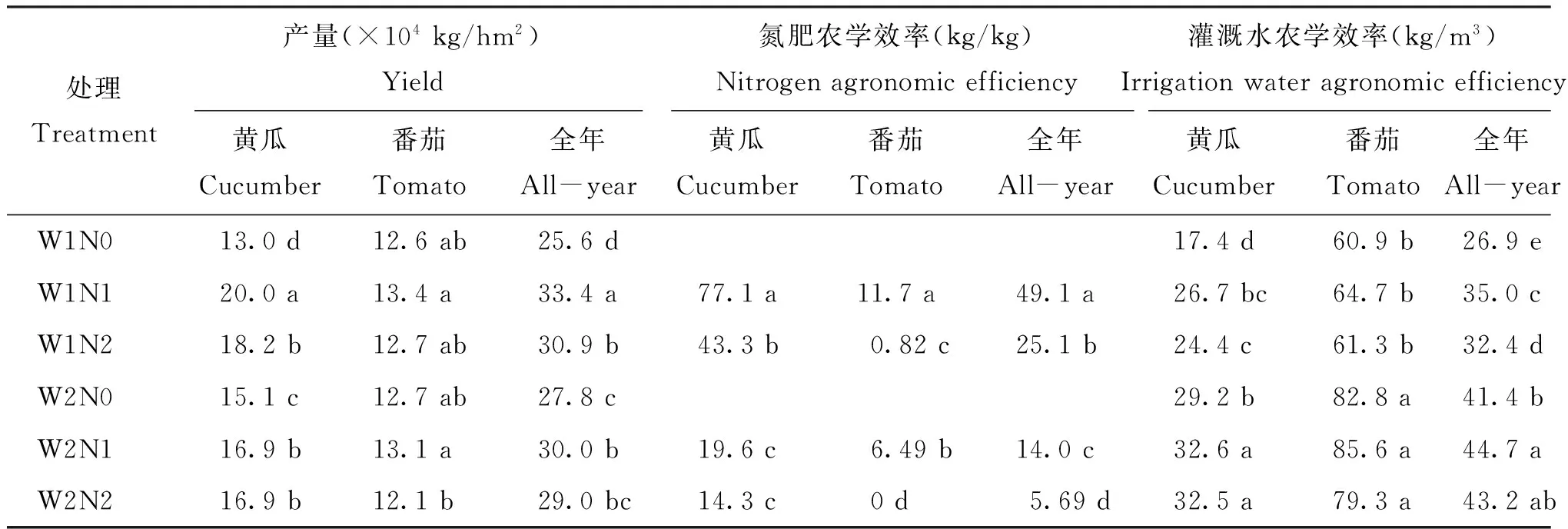
处理Treatment产量(×104kg/hm2)Yield黄瓜Cucumber番茄Tomato全年All-year氮肥农学效率(kg/kg)Nitrogenagronomicefficiency黄瓜Cucumber番茄Tomato全年All-year灌溉水农学效率(kg/m3)Irrigationwateragronomicefficiency黄瓜Cucumber番茄Tomato全年All-yearW1N013.0d12.6ab25.6d17.4d60.9b26.9eW1N120.0a13.4a33.4a77.1a11.7a49.1a26.7bc64.7b35.0cW1N218.2b12.7ab30.9b43.3b0.82c25.1b24.4c61.3b32.4dW2N015.1c12.7ab27.8c29.2b82.8a41.4bW2N116.9b13.1a30.0b19.6c6.49b14.0c32.6a85.6a44.7aW2N216.9b12.1b29.0bc14.3c0d5.69d32.5a79.3a43.2ab
注(Note): 同列数据后不同字母表示差异达5%显著水平 Values followed by different letters in the same column are significantly different at the 5% level.
3.2灌水对设施菜地土壤氨挥发的影响

3.3其他环境因子对设施菜地土壤氨挥发的影响
其他环境因子如气温、 地温以及光照条件等均影响土壤的氨挥发[8,24]。由于本试验是在同一个温室内开展的定位研究,各处理的气象条件差异很小,这种差异对土壤氨挥发的影响可忽略不计。但气象因子本身对土壤氨挥发的影响具有一定的规律性,其主要是通过影响土壤中的铵态氮浓度间接影响土壤的氨挥发[8,24]。对于设施菜地来说,由于灌水和施肥量大,且施用频繁,气象因子对土壤氨挥发的影响往往被氮肥和灌水的影响所掩蔽。
4 结论


3)本试验条件下,节水30%、 减量施氮25%的水氮组合(W2N1)具有较佳的经济效益与环境效应。
[1]FAO. Statistical databases. Food and Agriculture Organization (FAO) of the United Nations[M/OL]. http://faostat3. fao. org., 2013.
[2]巨晓棠, 谷保静. 我国农田氮肥施用现状、 问题及趋势[J]. 植物营养与肥料学报, 2014, 20(4): 783-795.
Ju X T, Gu B J. Status-quo, problem and trend of nitrogen fertilization in China[J]. Journal of Plant Nutrition and Fertilizer, 2014, 20(4): 783-795.
[3]刘苹, 李彦, 江丽华, 等. 施肥对蔬菜产量的影响—以寿光市设施蔬菜为例[J]. 应用生态学报, 2014, 25(6): 1752-1758.
Liu P, Li Y, Jiang L H,etal. Effects of fertilizer application on greenhouse vegetable yield: A case study of Shouguang City[J]. Chinese Journal of Applied Ecology, 2014, 25(6): 1752-1758.
[4]Min J, Zhao X, Shi W M,etal. Nitrogen balance and loss in a greenhouse vegetable system in Southeastern China[J]. Pedosphere, 2011, 21(4): 464-472.
[5]Fan Z B, Lin S, Zhang X M,etal. Conventional flooding irrigation causes an overuse of nitrogen fertilizer and low nitrogen use efficiency in intensively used solar greenhouse vegetable production[J]. Agricultural Water Management, 2014, 144: 11-19.
[6]朱兆良.中国土壤氮素研究[J]. 土壤学报, 2008, 45(5): 778-783.
Zhu Z L. Research on soil nitrogen in China[J]. Acta Pedologica Scinica, 2008, 45(5): 778-783.
[7]Matsushima M, Lim S S, Kwak J H,etal. Interactive effects of synthetic nitrogen fertilizer and composted manure on ammonia volatilization from soils[J]. Plant and Soil, 2009, 325(1/2): 187-196.
[8]Gong W W, Zhang Y S, Huang X F,etal. High-resolution measurement of ammonia emissions from fertilization of vegetable and rice crops in the Pearl River Delta Region, China[J]. Atmospheric Environment, 2013, 65: 1-10.
[9]王书伟, 廖千家骅, 胡玉婷, 等. 我国 NH3-N排放量及空间分布变化初步研究[J]. 农业环境科学学报, 2009, 28(3): 619-626.
Wang S W, Liao Q J H, Hu Y T,etal. A preliminary inventory of NH3-N emission and its temporal and spatial distribution of China[J]. Journal of Agro-Environment Science, 2009, 28(3): 619-626.
[10]Ni K, Pacholski A, Kage H. Ammonia volatilization after application of urea to winter wheat over 3 years affected by novel urease and nitrification inhibitors[J]. Agriculture, Ecosystems and Environment, 2014, 197: 184-194.
[11]Huo Q, Cai X H, Kang L,etal. Estimating ammonia emissions from a winter wheat cropland in North China Plain with field experiments and inverse dispersion Modeling[J]. Atmospheric Environment, 2015, 104: 1-10.
[12]Han K, Zhou C J, Wang L Q. Reducing ammonia volatilization from maize fields with separation of nitrogen fertilizer and water in an alternating furrow irrigation system[J]. Journal of Integrative Agriculture, 2014, 13(5): 1099-1112.
[13]王朝辉, 刘学军, 巨晓棠, 张福锁. 田间土壤氨挥发的原位测定-通气法[J]. 植物营养与肥料学报, 2002, 8(2): 205-209.
Wang Z H, Liu X J, Ju X T, Zhang F S. Field in situ determination of ammonia volatilization from soil: venting method[J]. Plant Nutrition and Fertilizer Science, 2002, 8(2): 205-209.
[14]张琳, 孙卓玲, 马理, 等. 不同水氮条件下双氰胺(DCD)对温室黄瓜土壤氮素损失的影响[J]. 植物营养与肥料学报, 2015, 21(1): 128-137.
Zhang L, Sun Z L, Ma L,etal. Effects of dicyandiamide on nitrogen loss from cucumber planting soil in intensive greenhouse under different irrigation and nitrogen conditions[J]. Journal of Plant Nutrition and Fertilizer, 2015, 21(1): 128-137.
[15]郝小雨, 高伟, 王玉军, 等. 有机无机肥料配合施用对日光温室土壤氨挥发的影响[J]. 中国农业科学, 2012, 45(21): 4403-4414.
Hao X Y, Gao W, Wang Y J,etal. Effects of combined application of organic manure and chemical fertilizers on ammonia volatilization from greenhouse vegetable soil[J]. Scientia Agricultura Sinica, 2012, 45(21): 4403-4414.
[16]李银坤, 武雪萍, 梅旭荣, 等. 常规灌溉条件下施氮对温室土壤氨挥发的影响[J]. 农业工程学报, 2011, 27(7): 23-30.
Li Y K, Wu X P, Mei X R,etal. Effects of nitrogen application on ammonia volatilization in greenhouse soil under condition of conventional irrigation[J]. Transactions of the CSAE, 2011, 27(7): 23-30.
[17]习斌, 张继宗, 左强, 等. 保护地菜田土壤氨挥发损失及影响因素研究[J]. 植物营养与肥料学报, 2010, 16(2): 327-333.
Xi B, Zhang J Z, Zuo Q,etal. Study on the losing of ammonia volatilization and its influencing factors on the protected vegetable fields' soil[J]. Plant Nutrition and Fertilizer Science, 2010, 16(2): 327-333.
[18]Cantarella H, Mattos D, Quaggio J A,etal. Fruit yield of Valencia sweet orange fertilized with different N sources and the loss of applied N[J]. Nutrient Cycling in Agroecosystems, 2003, 67(3): 215-223.
[19]葛顺峰, 姜远茂, 魏绍冲, 房祥吉. 不同供氮水平下幼龄苹果园氮素去向初探[J]. 植物营养与肥料学报, 2011, 17(4): 949-955.
Ge S F, Jiang Y M, Wei S C, Fang X J. Nitrogen balance under different nitrogen application rates in young apple orchards[J]. Plant Nutrition and Fertilizer Science, 2011, 17(4): 949-955.
[20]翟学旭, 王振林, 戴忠民, 等. 灌溉与非灌溉条件下黄淮冬麦区不同追氮时期农田土壤氨挥发损失研究[J]. 植物营养与肥料学报, 2013, 19(1): 54-64.
Zhai X X, Wang Z L, Dai Z M,etal. Ammonia volatilization loss in Huang Huai winter wheat cultivation areas under irrigated and rainfed conditions[J]. Plant Nutrition and Fertilizer Science, 2013, 19(1): 54-64.
[21]Jantalia C P, Halvorson A D, Follett R F,etal. Nitrogen source effects on ammonia volatilization as measured with semi-static chamber[J]. Agronomy Journal, 2012, 104(6): 1595-1603.
[22]Holcomb J C, Sullivan D M, Horneck D A, Clough G H. Effect of irrigation rate on ammonia volatilization[J]. Soil Science Society of America Journal, 2011, 75(6): 2341-2347.
[23]高鹏程, 张一平. 氨挥发与土壤水分散失关系的研究[J]. 西北农林科技大学学报(自然科学版), 2001, 29(6): 22-26.
Gao P C, Zhang Y P. Research on relationship between volatilization of ammonia and evaporation of soil water[J]. Journal of Northwest A&F University (Natural Science Edition), 2001, 29(6): 22-26.
[24]上官宇先, 师日鹏, 李娜, 等. 垄作覆膜条件下田间氨挥发及影响因素[J].环境科学, 2012, 33(6) : 1987-1993.
Shangguan Y X, Shi R P, Li N,etal. Factors influencing ammonia volatilization in a winter wheat field with plastic film mulched ridges and unmulched furrows[J]. Environmental Science, 2012, 33(6): 1987-1993.
Effects of irrigation and nitrogen application on ammonia volatilization loss from vegetable fields under greenhouse cultivation
LI Yin-kun1, WU Xue-ping2*, WU Qi-fu3, WU Hui-jun2
(1BeijingResearchCenterofIntelligentEquipmentforAgriculture,Beijing100097,China; 2NationalEngineeringLaboratoryforImprovingQualityofArableLand/InstituteofAgriculturalResourceandRegionalPlanning,ChineseAcademyofAgricultureSciences,Beijing100081,China; 3InnerMongoliaLow-CarbonResearchInstitute,Hohhot010010,China)
【Objectives】 Excessive nitrogen fertilization and irrigation are common phenomena in greenhouse cultivated vegetable production in China. Objectives of this study were to identify characteristics of soil ammonia volatilization under different irrigation and nitrogen conditions, and to investigate impacts of important factors on soil ammonia volatilization in a cucumber-tomato rotation system. 【Methods】 The study was carried out with two irrigation levels, traditional irrigation (W1) and reduced irrigation quantity (W2), and three nitrogen application rates, traditional nitrogen rate (N2), reduced by 25% from traditional nitrogen rate (N1) and no nitrogen application (N0). There were six treatments, W1N0, W1N1, W1N2, W2N0,W2N1 and W2N2. The venting method was used to investigate the dynamics of ammonia volatilization and the key impact factors related to soil ammonia volatilization in the vegetable fields in the North China Plain. 【Results】 The nitrogen rates have significant effect on the ammonium nitrogen contents of topsoil (0-10 cm depth) in the cucumber-tomato rotation system. Compared to the traditional nitrogen treatment (N2), the peak value of the ammonium nitrogen concentration is reduced by 25.1%-30.3% (P<0.05) in the reduced nitrogen treatment (N1) under the same irrigation condition. Reduction of the nitrogen rate significantly reduces the soil ammonia volatilization rate. Compared to the traditional nitrogen treatment (N2), the average rates of soil ammonia volatilization are reduced by 21.1%-22.8% (P<0.05) and 16.5%-17.9% (P<0.05) in the cucumber growing season and tomato growing season, respectively. The ammonia volatilization amount and loss ratio of the nitrogen fertilizer are 17.8-48.1 kg/hm2and 1.23%-1.44% in the cucumber-tomato rotation system, respectively. Compared to the N2 treatment, the ammonia volatilization amount and loss ratio of the nitrogen fertilizer of the N1 treatment are reduced by 19.3%-20.0% (P< 0.05) and 0.85-0.92 percentage point, respectively. There is a significantly positive correlation between the soil ammonia volatilization rate and 0-10 cm soil ammonium nitrogen concentration, which shows that the 0-10 cm soil ammonium nitrogen concentration is one of the important factors affecting soil ammonia volatilization. The soil ammonia volatilization rate and ammonia volatilization amount in the reduced irrigation treatment (W2) are higher than those in the traditional irrigation treatment (W1) (P>0.05). Appropriate reduction of the nitrogen fertilizer and irrigation application not only has high vegetable production, but also significantly increases the irrigation water and nitrogen use efficiencies. Compared to the N2 treatment, the nitrogen agronomic efficiency is increased by 95.4%-146.4% in the N1 treatment, and compared to the W1 treatment, the irrigation water agronomic efficiency of the W2 treatment is increased by 27.7%-54.0%. 【Results】 By taking the reasonable measure of water-saving and nitrogen application reduction, the objectives of reducing the ammonia volatilization, increasing the yield and improving the irrigation water and nitrogen use efficiencies can be achieved. In summary, the combination of water-saving irrigation by 30% and nitrogen fertilizer reduction by 25% (W2N1) can make a good economic benefit and environmental effect in this experiment.

2015-05-08接受日期: 2015-06-13网络出版日期: 2015-08-19
国家高技术研究发展计划项目 (2013AA102901); 北京市农林科学院科技创新能力建设专项(KJCX20140415); 公益性行业(农业)科研专项(201203077); 北京市农林科学院青年基金(QNJJ201421); 北京市优秀人才项目(2015000057592G267)资助。
李银坤(1982—), 男, 山东菏泽人, 博士, 主要从事水肥高效利用及水肥一体化技术研究。 E-mail: lykun1218@163.com
E-mail: xpwu@caas.ac.cn
S143.1; S155.4+1
A
1008-505X(2016)04-0949-09

